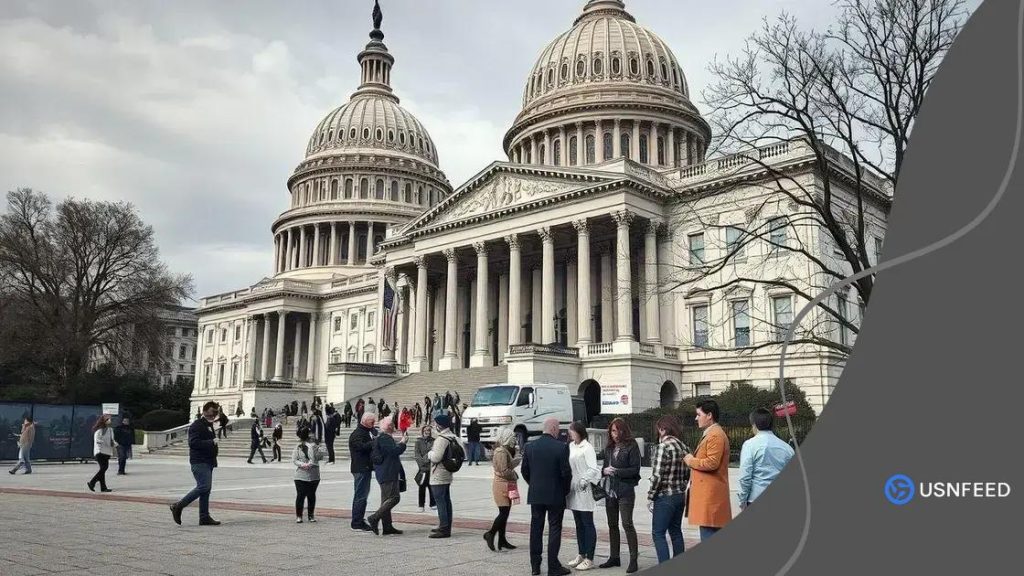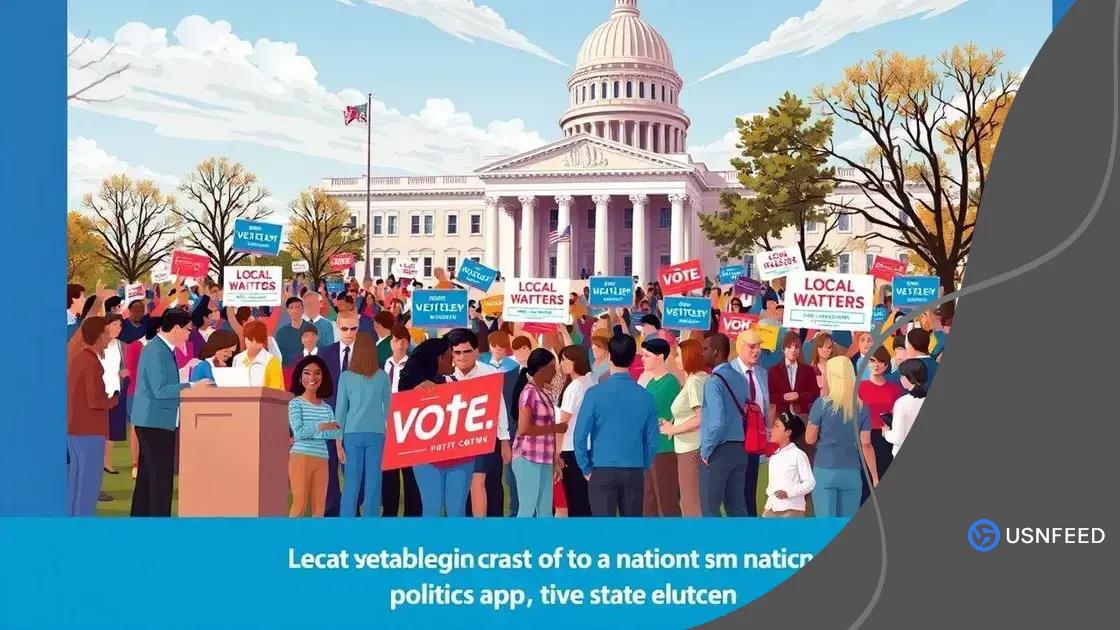Current updates on the US political landscape: what you need to know

Current updates on the US political landscape reveal key issues such as healthcare, climate change, and economy influencing the upcoming presidential race, while state elections significantly impact national political dynamics.
Current updates on the US political landscape reveal a constantly shifting environment. Have you noticed how recent events influence everyday life? Let’s dive into what’s happening and why it matters.
Recent polling trends and their implications
Recent polling trends provide valuable insights into the current updates on the US political landscape. Understanding these trends can help us predict future elections and gauge public opinion on crucial issues. Polls act like a snapshot of how voters feel, portraying their concerns and priorities.
Key Polling Data
Various organizations conduct polls to capture the mood of the electorate. The results can show shifts in support for candidates, political parties, and hot-button issues. When trends emerge from these polls, they can signal potential changes in voter behavior.
- Be aware of demographic shifts in voting patterns.
- Track how approval ratings of officials impact election outcomes.
- Consider the role of social media in shaping public perception.
Furthermore, many voters respond differently to polling questions based on how they feel about events in the news. This variability can cause sudden spikes or drops in support for a candidate. Analyzing specific trending topics helps to understand what influences the electorate.
For instance, topics like the economy, healthcare, and immigration consistently rank high in importance for voters. As the political climate changes, so do the issues at the forefront of public discussion. Monitoring these polling trends can guide campaigns and inform policy decisions.
Implications of Polling Trends
The implications of polling trends extend beyond mere numbers. They provide an overview of what voters prioritize and how they may react in upcoming elections. Campaign strategies are often adjusted based on polling feedback.
- Polling data helps candidates focus their messages on key voter concerns.
- Campaigns can allocate resources efficiently by targeting areas with determined voter interests.
- An understanding of polling trends allows parties to adapt their platforms to appeal to the electorate.
Your understanding of recent polling trends can significantly influence how you perceive the shifting political landscape. Engaging with these trends keeps you informed about not just who is leading in the polls but also why they may be gaining or losing support.
Key legislative changes in Congress
Key legislative changes in Congress shape the framework of our government and affect all citizens. Understanding these changes is essential for staying informed on how laws impact daily life.
Recent Legislative Highlights
Recently, Congress has enacted several significant laws. These new regulations address various issues, from climate change to healthcare reform. Each piece of legislation has its own implications, affecting different segments of the population.
- Infrastructure Act: This act aims to improve roads, bridges, and public transit.
- Healthcare Reform: New measures aim to expand coverage and reduce costs for insurance.
- Climate Legislation: Policies designed to combat climate change have been introduced, emphasizing renewable energy.
These highlights demonstrate how lawmakers respond to pressing national issues. The continuous flow of new proposals and adjustments signifies the ongoing evolution of American politics.
Impact of Legislative Changes
Each legislative change can have widespread effects. Understanding the implications helps citizens navigate the current political landscape. For instance, changes in healthcare policies can affect millions, changing the way people access medical services.
Additionally, infrastructure improvements not only create jobs but also enhance the quality of life in communities. By investing in public transport and roads, the government aims to boost the economy and improve daily commutes.
As Congress debates and decides on various bills, the impact of these discussions reaches far and wide. Citizens should stay engaged and informed about potential changes that might affect them personally.
The impact of state elections on national politics

The impact of state elections on national politics is profound and often underestimated. State elections serve as a barometer for national trends, reflecting the mood and priorities of the electorate.
How State Elections Influence National Politics
State elections can significantly shift the balance of power in Congress and alter the direction of federal policies. When parties gain control of state legislatures, they can influence redistricting and establish policies that may align with their national platform.
- Redistricting: Winning state elections grants parties control over drawing congressional district lines.
- Policy Alignment: State policies can reflect national issues, reinforcing party ideologies.
- Voter Sentiment: Trends in state elections often signal larger national sentiments among voters.
The outcomes of state races can lead to shifts in national conversations regarding critical issues such as healthcare, education, and taxation. When voters express discontent at the state level, it can pressure national leaders to respond effectively.
Recent Examples of State Elections Shaping National Outcomes
In recent years, key state elections have dramatically influenced the national political landscape. For instance, increased voter turnout in key battleground states during midterm elections can lead to shifts in Congressional control. Likewise, governor races can establish crucial policies that align with federal ambitions.
Additionally, some states serve as test cases for policies that could be adopted nationally. Legislative changes in one state can inspire movements in others, showcasing the interconnectedness of state and national politics. The way states handle major issues can reverberate, affecting the national agenda.
Understanding the impact of state elections on national politics is crucial for voters. Engaging in local elections empowers individuals to make a difference in their communities and shows how these decisions influence larger political dynamics.
Major issues shaping the political debate
Major issues shaping the political debate are critical in determining voter priorities and influencing candidate positions. Understanding these issues helps voters make informed decisions in elections and contributes to public discourse.
Current Key Issues
Several major issues dominate the political landscape. Each of these topics evokes strong opinions and sparks discussion:
- Healthcare: Access to affordable healthcare remains a top concern for voters. Proposals range from expanding existing programs to introducing new systems.
- Climate Change: Environmental issues are increasingly prominent, with debates on how to address climate change and its effects on future generations.
- Economy: Economic stability, inflation, and job creation influence voter sentiment. Discussions around wage growth, worker rights, and taxation are central to political campaigns.
These issues are interconnected and often affect one another. For instance, economic policies can impact healthcare funding, while climate change strategies may influence job creation in new industries.
How Issues Affect Political Campaigns
As candidates enter elections, they often adopt positions that align with the major issues of the time. Voters increasingly seek politicians who address their concerns directly. Candidates must connect their platforms to these issues to gain support.
Additionally, public debates and forums serve as platforms for addressing major issues head-on. Candidates are often challenged to explain their stances on healthcare, climate change, and the economy. The ability to articulate clear, actionable plans can significantly sway undecided voters.
With each election cycle, the focus may shift among these major issues, reflecting the priorities of the electorate. Engaging in these discussions enhances civic participation and encourages voters to advocate for their interests.
Future predictions for the presidential race
Future predictions for the presidential race are highly anticipated by political analysts, voters, and candidates alike. Understanding trends and voter sentiment can provide insight into potential outcomes.
Current Landscape and Key Factors
The current political climate sets the stage for the next presidential election. Several factors will play a critical role in shaping the race. The economy, social issues, and key endorsements can sway public opinion significantly.
- Economic Conditions: Strong economic performance can boost an incumbent’s chances, while economic downturns may favor challengers.
- Voter Turnout: High turnout among young and minority voters can significantly influence election results.
- Key Issues: Candidates who address pressing issues like healthcare and climate change may gain traction with voters.
As the election approaches, candidates are likely to refine their messages to resonate with voters. Historically, a candidate’s ability to connect with voters on major issues is decisive in winning elections.
Polling Trends and What They Indicate
Polling data is a crucial tool for predicting electoral outcomes. As primary elections occur, polls provide insight into candidate popularity and voter preferences. Trends in these polls can signal shifts in voter sentiment.
For example, if a candidate consistently leads in polls among key demographics, that can indicate a robust campaign strategy. Conversely, significant drops in approval ratings may highlight vulnerabilities. Analysts will closely monitor these changes as they reflect the dynamic nature of the race.
By engaging with public sentiment and leveraging data, candidates can better position themselves for success. As predictions unfold, each twist in the race will keep voters and analysts alike eagerly awaiting the next chapter in the presidential election saga.
In conclusion, understanding key issues and trends in the political landscape is crucial for voters as they prepare for upcoming elections. The impact of state elections, healthcare, climate change, and economic policies are just a few of the elements shaping the future of national politics. As we look forward to the presidential race, staying informed about candidates and their positions will enhance civic engagement, ultimately empowering citizens to make informed choices at the ballot box.
FAQ – Frequently Asked Questions about the US Political Landscape
What are the major issues influencing the upcoming presidential race?
Key issues include healthcare, climate change, and the economy, all of which play a crucial role in shaping voter opinions and campaign strategies.
How do state elections affect national politics?
State elections can shift Congressional control, influence redistricting, and impact key legislation at the national level.
Why is polling data important in elections?
Polling data provides insights into voter sentiment and can predict electoral outcomes, helping candidates adjust their strategies accordingly.
How can I stay informed about political developments?
Following credible news sources, engaging in community discussions, and participating in local elections can help you stay updated on political developments.